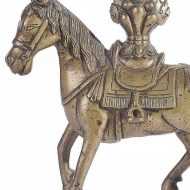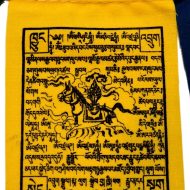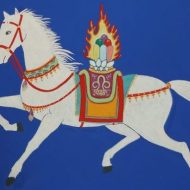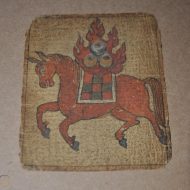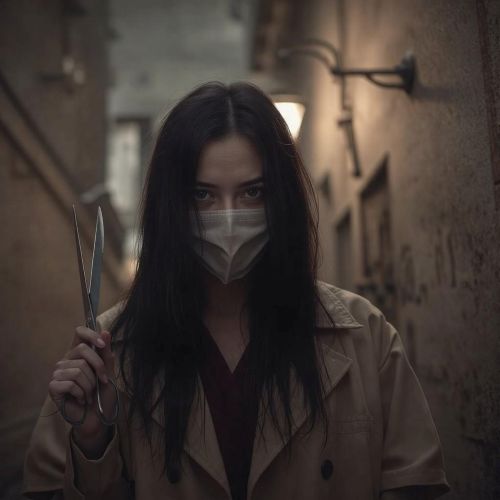Wind Horse : The Flying Horse
Listen
At a glance
| Description | |
|---|---|
| Origin | Tibetan Mythology |
| Classification | Animals |
| Family Members | N/A |
| Region | Tibet |
| Associated With | Speed, Wind, Luck |
Wind Horse or rlung rta
Introduction
The Wind Horse is a Tibetan Buddhism term that refers to a creature that can carry the wishes of the people and the gods using the wind. They are also known to appear in the popular multi coloured prayer flags that can be seen in images of the Himalayan regions. These Tibetan prayer flags are often strung around the Tibetan mountains and the greater Himalayas to symbolize the blessings of the ancestors. They are also quite popular amongst bikers in India who travel to Leh and Ladakh.
Physical Traits
The Wind Horse is depicted as a white horse with a flowing mane and most of the time without wings. They carry a saddle which has the 3 wish fulfilling jewels which is some descriptions are shown as glowing or be in flames.
Other Names
There has long been confusion over the spelling because the sound produced by the word can be spelt either klung rta “river horse” or rlung rta “wind horse”. According to Karmay, the term “river horse” originated from the Tibetan nag rtsis system, which is a system of astrology that originated in China. It has four basic elements: srog, lu, wangtang, and lungta. It is believed that the concept of the river horse, which later changed to wind horse, originated from the Chinese tradition of the dragon horse.
Powers and Abilities
Wind Horse is used to symbolise good fortune and well-being. In other words, it is a symbol of luck. Its appearance is supposed to bring peace, wealth, and harmony. Being associated with swiftness, speed and the wind, there is debate over whether it has the ability of flight.
Modern Day Influence
Ceremonies are usually performed in conjunction with the “lhasang” ritual, which involves the burning of juniper branches to create thick and aromatic smoke. It is believed that this ritual increases the strength of the worshippers’ four rtsis elements.
Related Images
Source
Wikipedia: Wind Horse. https://en.wikipedia.org/wiki/Wind_Horse
Gods and Monsters: Wind Horse. https://godsandmonsters.info/wind-horse/
Tibetan Buddhist Encyclopedia: Wind Horse. https://tibetanbuddhistencyclopedia.com/en/index.php/Wind_Horse
Frequently Asked Questions
What is the meaning of the wind horse?
The wind horse, a symbol found in East Asian and Central Asian shamanism and Tibetan Buddhism, holds multifaceted meanings. It represents the human soul, embodying our boundless energy and potential. As a bearer of good fortune, it carries our wishes and aspirations towards fulfillment. It also signifies “lungta,” the inherent goodness within each being, and encourages cultivating positive qualities.
What is the wind horse called?
The wind horse, a potent symbol across various cultures, goes by different names. In Tibetan Buddhism, it’s most commonly called “Lungta,” which literally translates to “wind horse.” Other names include “Longma” in Chinese, “Kanthaka” in Nepali, and “Surya” in Indian traditions. While the names vary, the wind horse’s core meaning remains constant, representing boundless energy, good fortune, inherent goodness, freedom, and the transformative power of the present moment.
What is the mythology of the wind horse?
The wind horse boasts a rich mythology spanning centuries and cultures. Its journey began in Central Asia’s shamanistic traditions, symbolizing the soul’s freedom and connection to the spirit world. Tibetan Buddhism adopted the wind horse, rechristening it “Lungta” and imbuing it with the power to carry prayers and aspirations. Its image adorned mandalas, representing the air element and the journey towards enlightenment. Ultimately, the wind horse’s enduring legacy reminds us of our potential for good, the interconnectedness of the universe, and the transformative power of the present moment.
What are the 4 horses in Buddhism?
The Four Horses represent different levels of understanding and engagement with Buddhist teachings. The Excellent Horse instantly grasps the teachings, while the Good Horse requires contemplation. The Poor Horse understands only through pain, and the Bad Horse remains resistant. Though metaphorical, they remind us that everyone progresses at their own pace on the path to enlightenment. The key is continued practice and perseverance.
What are the benefits of the wind horse?

